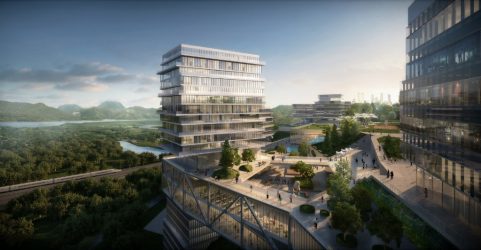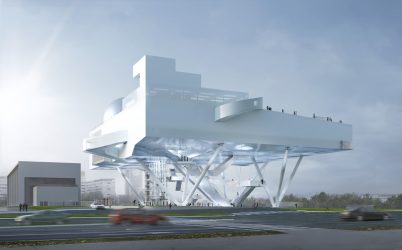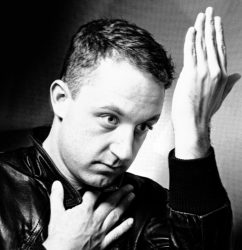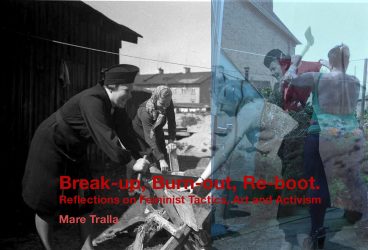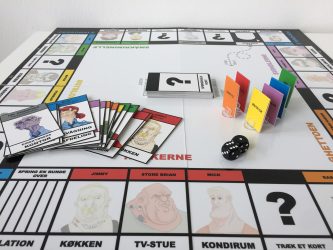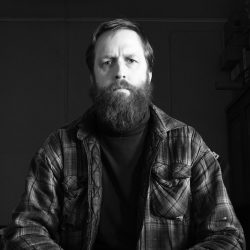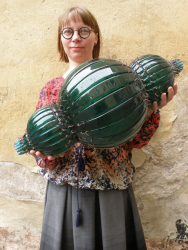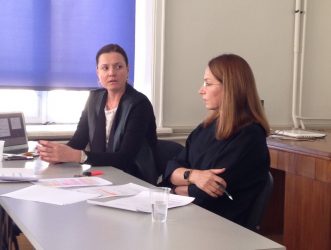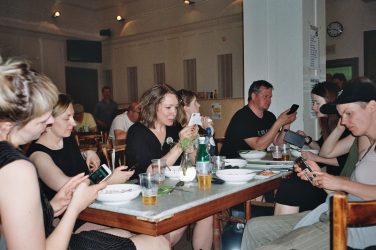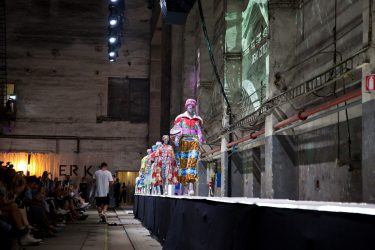Avatud loengud
08.11.2018
Jonathan Woodroffe (S333) annab 8. novembril EKAs avaliku loengu
Neljapäeval, 8. novembril kell 18.30 peab EKA aulas avaliku loengu “Produktiivsed linnad” arhitekt Jonathan Woodroffe (S333 Architecture + Urbanism), kes on töötanud suuremahuliste linnaplaneerimise ja arhitektuuriprojektidega nii Euroopas, Aasias kui USAs.
Modernistlik linn lõi tootmise, puhkamise ja elamistsoonid lahku. Produktiivsete linnade idee otsib töö olemuse muutumise ajastul võimalusi, kuidas need kolm linnalist tegevust uuesti kokku tuua – ühte linnaossa, ühte kvartalisse, isegi ühte majja. Kas see on võimalik? Oodatud on kõik arhitektuuri- ja ruumihuvilised, loeng on inglise keeles ning tasuta. Jonathan Woodroffe tuleb Tallinnasse seoses EKA arhitektuuriteaduskonna uurimisprojektiga Lõpetamata Linn, mis võtab sel semestril fookusesse linnakeskuse teema.
“Lõpetamata linn” on EKA Arhitektuuriteaduskonna poolt koostöös Tallinna linnaga läbiviidav kolmeaastane laiapõhjaline uurimistöö, mis küsib, milline võiks olla hea ja elamisväärne linn 21. sajandil ja kuidas see võiks väljenduda Tallinna linnaehituslikus arengus. Suuremahuline teadusprojekt keskendub Tallinna linnaehituslike visioonide ja ruumiliste tulevikustsenaariumite uurimisele. Uurimistöö läbiviimine saab teoks tänu kinnisvaraettevõtte Kapitel toetusele, kes panustab projekti kolme aasta jooksul kokku peaaegu pool miljonit eurot.
Jonathan Woodroffe (S333) annab 8. novembril EKAs avaliku loengu
Neljapäev 08 november, 2018
Neljapäeval, 8. novembril kell 18.30 peab EKA aulas avaliku loengu “Produktiivsed linnad” arhitekt Jonathan Woodroffe (S333 Architecture + Urbanism), kes on töötanud suuremahuliste linnaplaneerimise ja arhitektuuriprojektidega nii Euroopas, Aasias kui USAs.
Modernistlik linn lõi tootmise, puhkamise ja elamistsoonid lahku. Produktiivsete linnade idee otsib töö olemuse muutumise ajastul võimalusi, kuidas need kolm linnalist tegevust uuesti kokku tuua – ühte linnaossa, ühte kvartalisse, isegi ühte majja. Kas see on võimalik? Oodatud on kõik arhitektuuri- ja ruumihuvilised, loeng on inglise keeles ning tasuta. Jonathan Woodroffe tuleb Tallinnasse seoses EKA arhitektuuriteaduskonna uurimisprojektiga Lõpetamata Linn, mis võtab sel semestril fookusesse linnakeskuse teema.
“Lõpetamata linn” on EKA Arhitektuuriteaduskonna poolt koostöös Tallinna linnaga läbiviidav kolmeaastane laiapõhjaline uurimistöö, mis küsib, milline võiks olla hea ja elamisväärne linn 21. sajandil ja kuidas see võiks väljenduda Tallinna linnaehituslikus arengus. Suuremahuline teadusprojekt keskendub Tallinna linnaehituslike visioonide ja ruumiliste tulevikustsenaariumite uurimisele. Uurimistöö läbiviimine saab teoks tänu kinnisvaraettevõtte Kapitel toetusele, kes panustab projekti kolme aasta jooksul kokku peaaegu pool miljonit eurot.
01.11.2018
Arhitektuuriteaduskonna Avatud Loeng: Wolfgang Tschapeller
Neljapäeval, 1. novembril algusega kell 18.00 toimub Eesti Kunstiakadeemia suures saalis (Põhja pst 7) Viini kaunite kunstide akadeemia arhitektuuriosakonna dekaani, Austrias tegutseva arhitekti Wolfgang Tschapelleri avalik loeng. Tschapeller on tuntust pälvinud oma ebatavaliste projektidega, sh Cornelli ülikooli raamatukogu ja Viini rakenduskunsti ülikooli hoone laienduse, samuti Serbia teaduse edendamise keskuse uue hoone projektiga. Tschapeller tuleb Tallinnasse esinema EKA arhitektuuriteaduskonna avatud loengute sarja raames. Loengud toimuvad neljapäeviti iga kahe nädala tagant, on inglise keeles ning kõikidele huvilistele tasuta.
Tislerina alustanud Tschapeller jõudis arhitektuurini Viini rakenduskunsti ülikoolis ning seejärel Cornelli ülikoolis USAs õppides. Oma pika loomekarjääri jooksul on ta õpetanud Cornelli ülikoolis, Linzi kunstiakadeemias, Buffalo New Yorki osariigi ülikoolis. Aastast 2005 tegutseb ta Viini kaunite kunstide akadeemia arhitektuuri- ja kunstiosakonna professorina ning aastast 2011 on ta selle osakonna dekaan. Varem on Tschapeller käinud Eestis Betooniühingu ja Eesti Ehitusmaterjalide Tootjate Liidu poolt korraldatava Betoonipäeva peakõnelejana (2009).
Avatud loengute sarja kuraatori Johan Tali sõnul on Wolfgang Tschapelleri puhul tegemist Austria kaasaja ühe tähtsama arhitektiga. “Ta on pikaajaline Viini kaunite kunstide akadeemia arhitektuuriosakonna dekaan, progressiivse ruumihariduse toetaja ja kompromissitu praktik. Oma projektides kasutab Tschapeller kaasaegset vormikeelt ja uusi tehnoloogiaid ning materjale eeskätt selleks, et pakkuda uusi põnevaid ruumikogemusi ja seeläbi kasvõi hetkeks kõigutada gravitatsiooni vääramatut jõudu ning inimtaju mugavustsooni. Tschapelleri taust tislerina annab talle unikaalse eelise: asjade osadest konstrueerimine ja väljamõtlemine on iga projekti puhul detailirohke ja vaevarikas ülesanne, ning Tschapelleri loomingus on tulemuseks pea alati originaalne terviklahendus.”
Wolfgang Tschapelleri kohta lähemalt: www.tschapeller.com
Avatud loengut on kuulama oodatud kõikide Eesti koolide tudengid – olgu siis arhitektuuri, urbanistika, sisearhitektuuri või ka robootika, programmeerimise, disaini ning vabade kunstide valdkonnast; samuti tegutsevad arhitektid, õppejõud ning lihtsalt arhitektuuri- ja ruumihuvilised – lisaks kõik, kes kaaluvad tulevikus arhitektuuri õppima asumist. Avatud loengud on alati tasuta ja inglise keeles.
EKA arhitektuuri ja linnaplaneerimise osakond on arhitektuuri avatud loenguid korraldanud 2012. aastast alates – igal õppeaastal astub Tallinnas erialase publiku ette kümmekond valdkonna omanäolist praktikut ja hinnatud teoreetikut. EKA arhitektuuriteaduskond on Eesti arhitektuurihariduse keskpunkt ja olulisim kompetentsikeskus kõigis tehiskeskkonda loovates distsipliinides, hõlmates sisearhitektuuri, arhitektuuri ja linnaplaneerimise valdkonda.
Loengusarja toetab Eesti Kultuurkapital.
Kuraatorid: Sille Pihlak, Johan Tali
www.avatudloengud.ee
https://www.facebook.com/EKAarhitektuur/
Lisainfo:
Pille Epner
E-post: arhitektuur@artun.ee
Arhitektuuriteaduskonna Avatud Loeng: Wolfgang Tschapeller
Neljapäev 01 november, 2018
Neljapäeval, 1. novembril algusega kell 18.00 toimub Eesti Kunstiakadeemia suures saalis (Põhja pst 7) Viini kaunite kunstide akadeemia arhitektuuriosakonna dekaani, Austrias tegutseva arhitekti Wolfgang Tschapelleri avalik loeng. Tschapeller on tuntust pälvinud oma ebatavaliste projektidega, sh Cornelli ülikooli raamatukogu ja Viini rakenduskunsti ülikooli hoone laienduse, samuti Serbia teaduse edendamise keskuse uue hoone projektiga. Tschapeller tuleb Tallinnasse esinema EKA arhitektuuriteaduskonna avatud loengute sarja raames. Loengud toimuvad neljapäeviti iga kahe nädala tagant, on inglise keeles ning kõikidele huvilistele tasuta.
Tislerina alustanud Tschapeller jõudis arhitektuurini Viini rakenduskunsti ülikoolis ning seejärel Cornelli ülikoolis USAs õppides. Oma pika loomekarjääri jooksul on ta õpetanud Cornelli ülikoolis, Linzi kunstiakadeemias, Buffalo New Yorki osariigi ülikoolis. Aastast 2005 tegutseb ta Viini kaunite kunstide akadeemia arhitektuuri- ja kunstiosakonna professorina ning aastast 2011 on ta selle osakonna dekaan. Varem on Tschapeller käinud Eestis Betooniühingu ja Eesti Ehitusmaterjalide Tootjate Liidu poolt korraldatava Betoonipäeva peakõnelejana (2009).
Avatud loengute sarja kuraatori Johan Tali sõnul on Wolfgang Tschapelleri puhul tegemist Austria kaasaja ühe tähtsama arhitektiga. “Ta on pikaajaline Viini kaunite kunstide akadeemia arhitektuuriosakonna dekaan, progressiivse ruumihariduse toetaja ja kompromissitu praktik. Oma projektides kasutab Tschapeller kaasaegset vormikeelt ja uusi tehnoloogiaid ning materjale eeskätt selleks, et pakkuda uusi põnevaid ruumikogemusi ja seeläbi kasvõi hetkeks kõigutada gravitatsiooni vääramatut jõudu ning inimtaju mugavustsooni. Tschapelleri taust tislerina annab talle unikaalse eelise: asjade osadest konstrueerimine ja väljamõtlemine on iga projekti puhul detailirohke ja vaevarikas ülesanne, ning Tschapelleri loomingus on tulemuseks pea alati originaalne terviklahendus.”
Wolfgang Tschapelleri kohta lähemalt: www.tschapeller.com
Avatud loengut on kuulama oodatud kõikide Eesti koolide tudengid – olgu siis arhitektuuri, urbanistika, sisearhitektuuri või ka robootika, programmeerimise, disaini ning vabade kunstide valdkonnast; samuti tegutsevad arhitektid, õppejõud ning lihtsalt arhitektuuri- ja ruumihuvilised – lisaks kõik, kes kaaluvad tulevikus arhitektuuri õppima asumist. Avatud loengud on alati tasuta ja inglise keeles.
EKA arhitektuuri ja linnaplaneerimise osakond on arhitektuuri avatud loenguid korraldanud 2012. aastast alates – igal õppeaastal astub Tallinnas erialase publiku ette kümmekond valdkonna omanäolist praktikut ja hinnatud teoreetikut. EKA arhitektuuriteaduskond on Eesti arhitektuurihariduse keskpunkt ja olulisim kompetentsikeskus kõigis tehiskeskkonda loovates distsipliinides, hõlmates sisearhitektuuri, arhitektuuri ja linnaplaneerimise valdkonda.
Loengusarja toetab Eesti Kultuurkapital.
Kuraatorid: Sille Pihlak, Johan Tali
www.avatudloengud.ee
https://www.facebook.com/EKAarhitektuur/
Lisainfo:
Pille Epner
E-post: arhitektuur@artun.ee
02.11.2018
Tobias Kaspari kunstnikuvestlus “Iseseisvus”
Tobias Kaspari kunstnikuvestlus “Iseseisvus”
Reede 02 november, 2018
30.10.2018
Mare Tralla kunstnikuvestlus feministlikest taktikatest ja aktivismist
Mare Tralla kunstnikuvestlus feministlikest taktikatest ja aktivismist
Teisipäev 30 oktoober, 2018
08.11.2018
Thomas Markusseni avatud loeng sotsiaalsest disainist 8. novembril
Üks sotsiaalse disaini kesksetest küsimustest on, kuidas mõõta läbi uurimusliku lähenemise saavutatud ühiskondlikku väärtust.
Sageli samastatakse sotsiaalset disaini ekslikult lähedaste valdkondadega, näiteks sotsiaalse ettevõtluse või sotsiaalset innovatsiooni edendava disainiga. Tõsi, kõiki neid ühendab kodanike kaasatus protsessidesse, mis taotlevad sotsiaalseid muutusi või suuremat võrdsust. Ehkki sotsiaalsel disainil on mõningaid sarnaseid jooni ülalnimetatud lähenemistega, eksisteerib nende vahel ka rida olulisi erinevusi. Oma loengus “Sotsiaalne disain – kui väikestest muutustest piisab” toob Thomas Markussen need erinevused selgelt välja näidates ühtlasi, kuidas sotsiaalse disaini protsessid võivad tegelikult ühiskondlikke muutusi toetada.
Lisaks tutvustab ta Lõuna-Taani Ülikoolis läbiviidavat 3-aastast arendusprojekti “Sotsiaalsed mängud kuritegevuse vastu”. Projekti käigus on disainiuurijad välja arendanud innovatiivse lauamängu, mis on mõeldud mängimiseks lastele ja nende isadele, kes on mõistetud vangi Taani kõrgeima turvalisusega kinnipidamisasutustesse. Lauamäng on loodud tihedas koostöös noorte, vangide ja vanglatöötajatega ning see pakub platvormi üksteisemõistmiseks ja kommunikatsiooniks. Mängu eesmärgiks on aidata alaealistel paremini toime tulla probleemidega, mida lapsevanemate vanglas viibimine kaasa toob.
Thomas Markussen on Lõuna-Taani Ülikooli sotsiaalse disaini uurimisüksuse kaasasutaja ja dotsent. Oma töös keskendub Markussen sellele, kuidas saaks disaini rakendada poliitilise ja kriitilise esteetilise praktikana; eelkõige just sotsiaalse disaini, disainifiktsiooni ja -aktivismi valdkondades. Ta on ka viljakas autor; publikatsioonidest võiks esile tuua näiteks “The disruptive aesthetics of design activism: enacting design between art and politics” (Design Issues); “Disentangling the ‘social’ in social design’s engagement with the public realm” (CoDesign); and “The politics of design activism – from impure politics to parapolitics” appearing in Routledge’s forthcoming book Design and Dissent.
EKAs viibib Thomas Markussen disainiteaduskonna ja doktorikooli kutsel viies siin läbi rea seminare ja vestlusringe disainiuurimuse teemadel.
Thomas Markusseni avatud loeng sotsiaalsest disainist 8. novembril
Neljapäev 08 november, 2018
Üks sotsiaalse disaini kesksetest küsimustest on, kuidas mõõta läbi uurimusliku lähenemise saavutatud ühiskondlikku väärtust.
Sageli samastatakse sotsiaalset disaini ekslikult lähedaste valdkondadega, näiteks sotsiaalse ettevõtluse või sotsiaalset innovatsiooni edendava disainiga. Tõsi, kõiki neid ühendab kodanike kaasatus protsessidesse, mis taotlevad sotsiaalseid muutusi või suuremat võrdsust. Ehkki sotsiaalsel disainil on mõningaid sarnaseid jooni ülalnimetatud lähenemistega, eksisteerib nende vahel ka rida olulisi erinevusi. Oma loengus “Sotsiaalne disain – kui väikestest muutustest piisab” toob Thomas Markussen need erinevused selgelt välja näidates ühtlasi, kuidas sotsiaalse disaini protsessid võivad tegelikult ühiskondlikke muutusi toetada.
Lisaks tutvustab ta Lõuna-Taani Ülikoolis läbiviidavat 3-aastast arendusprojekti “Sotsiaalsed mängud kuritegevuse vastu”. Projekti käigus on disainiuurijad välja arendanud innovatiivse lauamängu, mis on mõeldud mängimiseks lastele ja nende isadele, kes on mõistetud vangi Taani kõrgeima turvalisusega kinnipidamisasutustesse. Lauamäng on loodud tihedas koostöös noorte, vangide ja vanglatöötajatega ning see pakub platvormi üksteisemõistmiseks ja kommunikatsiooniks. Mängu eesmärgiks on aidata alaealistel paremini toime tulla probleemidega, mida lapsevanemate vanglas viibimine kaasa toob.
Thomas Markussen on Lõuna-Taani Ülikooli sotsiaalse disaini uurimisüksuse kaasasutaja ja dotsent. Oma töös keskendub Markussen sellele, kuidas saaks disaini rakendada poliitilise ja kriitilise esteetilise praktikana; eelkõige just sotsiaalse disaini, disainifiktsiooni ja -aktivismi valdkondades. Ta on ka viljakas autor; publikatsioonidest võiks esile tuua näiteks “The disruptive aesthetics of design activism: enacting design between art and politics” (Design Issues); “Disentangling the ‘social’ in social design’s engagement with the public realm” (CoDesign); and “The politics of design activism – from impure politics to parapolitics” appearing in Routledge’s forthcoming book Design and Dissent.
EKAs viibib Thomas Markussen disainiteaduskonna ja doktorikooli kutsel viies siin läbi rea seminare ja vestlusringe disainiuurimuse teemadel.
25.10.2018
Paulis Liepa kunstnikuvestlus 25.10 kell 17.00 ruumis A202
Paulis Liepa kunstnikuvestlus
25.10 kell 17.00 ruumis A202
Paulis Liepa(1978) kasutab oma loomingus ühte graafika baastehnikat – kollograafiat ehk eseme- ja materjalitrüki tehnikat. Tehnika, mis on nii lihtne, kui elu ise. Nuga, papp, liim ja hetkes olemine päikselisel pärastlõunal, kui aeg peatab unistused tulevikust ja muutub mälestusteks, mida kunagi pole olnud. Meie plaanid, lootused ja lõpetamata projektid muutuvad udusteks, kaduvateks fragmentideks ja hetkelisteks meeleoludeks – sümbolid, piltkirjad ja kulunud kõne kinnitavad end igasse pildi ruutu, muutes kujutise päevikuks teadmata aegadest ja kohtadest.
Paulis Liepa elab ja töötab Riias ta on lõpetanud Janiz Rozentals’i kunstikooli ning magistrikraadiga Läti Kunstiakadeemia graafika eriala. Liepa on töötanud mitmeid aastaid animaatori ja produktsioonijuhina stuudios Vilks, lisaks kujundanud mitmeid raamatu kujundusi, illustratsioone ja plakateid. Tema teoseid on eksponeeritud mitmetes rahvusvahelistes muuseumides ja galeriides. Hiljutisemad projektid: isikunäitused “Cabinet of the Fine Arts”(2017) ja “Noise”(2015) Mukasala kunstisalongis Riias, “What is time?” viennacontemporary 2017 Viinis ning grupinäitused “International Print Triennial – Krakow 2015” Krakowis, “Telling Tales. Swiss and Baltic Artists” Bielis, Vilniuses ja Tallinnas(2014).
Paulis Liepa viib Eesti Kunstiakadeemia graafika osakonnas läbi töötuba “Autoritehnika”.
Vestlus toimub inglise keeles.
Paulis Liepa kunstnikuvestlus 25.10 kell 17.00 ruumis A202
Neljapäev 25 oktoober, 2018
Paulis Liepa kunstnikuvestlus
25.10 kell 17.00 ruumis A202
Paulis Liepa(1978) kasutab oma loomingus ühte graafika baastehnikat – kollograafiat ehk eseme- ja materjalitrüki tehnikat. Tehnika, mis on nii lihtne, kui elu ise. Nuga, papp, liim ja hetkes olemine päikselisel pärastlõunal, kui aeg peatab unistused tulevikust ja muutub mälestusteks, mida kunagi pole olnud. Meie plaanid, lootused ja lõpetamata projektid muutuvad udusteks, kaduvateks fragmentideks ja hetkelisteks meeleoludeks – sümbolid, piltkirjad ja kulunud kõne kinnitavad end igasse pildi ruutu, muutes kujutise päevikuks teadmata aegadest ja kohtadest.
Paulis Liepa elab ja töötab Riias ta on lõpetanud Janiz Rozentals’i kunstikooli ning magistrikraadiga Läti Kunstiakadeemia graafika eriala. Liepa on töötanud mitmeid aastaid animaatori ja produktsioonijuhina stuudios Vilks, lisaks kujundanud mitmeid raamatu kujundusi, illustratsioone ja plakateid. Tema teoseid on eksponeeritud mitmetes rahvusvahelistes muuseumides ja galeriides. Hiljutisemad projektid: isikunäitused “Cabinet of the Fine Arts”(2017) ja “Noise”(2015) Mukasala kunstisalongis Riias, “What is time?” viennacontemporary 2017 Viinis ning grupinäitused “International Print Triennial – Krakow 2015” Krakowis, “Telling Tales. Swiss and Baltic Artists” Bielis, Vilniuses ja Tallinnas(2014).
Paulis Liepa viib Eesti Kunstiakadeemia graafika osakonnas läbi töötuba “Autoritehnika”.
Vestlus toimub inglise keeles.
25.10.2018
Klaasikunstnik Marta Gibiete avatud loeng
Klaasikunstnik Marta Gibiete avatud loeng
Neljapäev 25 oktoober, 2018
28.11.2018
Infotund: EKAs valminud teostega “kauplemine” turul
Infotund: EKAs valminud teostega “kauplemine” turul
28.11 kl 14.30 – 16.00
ruumis A202
EKAs valmib igapäevaselt palju erinevaid teoseid: fotod, kursuse- ja lõputööd, raamatud, maalid, skulptuurid, tellimustööd koostöös ettevõtete ja organisatsioonidega jne. Iga loometegevuse alguses on osapooltel võimalik kirjalikult kokku leppida kuidas jagunevad teose autorid ja õigused ning milline saab olema teosega “kauplemise” viis.
Küsimused, mida infotunnis käsitleme:
1) Kes on õppeprotsessis valminud teoste autoriteks EKAs ?
2) Missugused on autoriõigused?
3) Kuidas jaotuvad autorite varalised õigused tudengite, õppejõudude ja EKA vahel?
4) Missugused on võimalikud autoriõigustega seotud kokkulepped koostöölepingutes, et vältida hilisemaid vaidlusi ja varalisi kahjusid?
Käsitleme küsimusi jooksva arutelu vormis. Kui teil on konkreetseid küsimusi, millele soovite infotunnis vastust saada, siis palun saata küsimused juba eelnevalt e-posti aadressile: kelli.turmann@artun.ee, et saaksime konkreetseid huvisid arvesse võtta infotunniks ettevalmistamisel.
Infotundi korraldab EKA teadus- ja arendusosakond. Sissejuhatavad ettekanded ettevõtluskoordinaatorilt Ingela Heinaste’lt ja jurist Anne-Riin Kütt’ilt.
Infotund: EKAs valminud teostega “kauplemine” turul
Kolmapäev 28 november, 2018
Infotund: EKAs valminud teostega “kauplemine” turul
28.11 kl 14.30 – 16.00
ruumis A202
EKAs valmib igapäevaselt palju erinevaid teoseid: fotod, kursuse- ja lõputööd, raamatud, maalid, skulptuurid, tellimustööd koostöös ettevõtete ja organisatsioonidega jne. Iga loometegevuse alguses on osapooltel võimalik kirjalikult kokku leppida kuidas jagunevad teose autorid ja õigused ning milline saab olema teosega “kauplemise” viis.
Küsimused, mida infotunnis käsitleme:
1) Kes on õppeprotsessis valminud teoste autoriteks EKAs ?
2) Missugused on autoriõigused?
3) Kuidas jaotuvad autorite varalised õigused tudengite, õppejõudude ja EKA vahel?
4) Missugused on võimalikud autoriõigustega seotud kokkulepped koostöölepingutes, et vältida hilisemaid vaidlusi ja varalisi kahjusid?
Käsitleme küsimusi jooksva arutelu vormis. Kui teil on konkreetseid küsimusi, millele soovite infotunnis vastust saada, siis palun saata küsimused juba eelnevalt e-posti aadressile: kelli.turmann@artun.ee, et saaksime konkreetseid huvisid arvesse võtta infotunniks ettevalmistamisel.
Infotundi korraldab EKA teadus- ja arendusosakond. Sissejuhatavad ettekanded ettevõtluskoordinaatorilt Ingela Heinaste’lt ja jurist Anne-Riin Kütt’ilt.
23.10.2018
EKA FOTO 20 viimane klubi – “Foto avatud väljal”
24. oktoobril kell 18:00 toimub EKKMi kohvikus järjekorras neljas EKA FOTO 20 klubiõhtu. Vestluse teemaks on “Foto avatud väljal”. Vestlusring toimub inglise keeles.
Võibolla on “fotograafia” – “valgusega joonistamine” – liiga tagasihoidlik termin hõlmamaks täna selle sõnaga tähistatavate kultuuriliste, sotsiaalsete, teaduslike ja sõjaliste praktikate paljusust. Foto singulaarse kujundi jäikus pingestub andmevoogude peatumatu ringluse vastu, luues ruumi- ja võimusuhteid viisidel, mis tihti inimsilmale nähtavad pole. Milliseid kunstiteooriast väljapoole jäävaid valdkondi ja protsesse kunstnikud jälgivad, et teha fotograafiaga huvitavaid asju ja tähele panna, mida fotograafia maailmaga teeb?
Vestlust modereerib Kristel Raesaar ning osalevad Marge Monko, Maija Rudovska, Hirohisa Koike ja Paul Paper.
Jäätist pakub Chicks on Icecream ning DJ on Marta Vaarik.
EKA foto 20 visuaalse identiteedi autoriteks on graafilise disaini osakonna tudengid Mai Bauvald ja Ran-Re Reimann. EKA FOTO 20 veebileht, mis täieneb aasta jooksul infoga osakonna ajaloo kohta, on kättesaadav siin: https://www.foto.artun.ee/.
Täname: Mai Bauvald, Ran-Re Reimann ja Anneli Kripsaar, Eve Kiiler, Marco Laimre, Eesti Kultuurkapital, Eesti Kaasaegse Kunsti Muuseum.
Kogu ürituste programmi saab jälgida siin:
- Eesti Kunstiakadeemia koduleht: https://www.foto.artun.ee/
- Facebook: https://www.facebook.com/EKA-Fotograafia-142012159217400/?ref=br_rs
- Sündmus 24. oktoobril EKKMis: https://www.facebook.com/events/192474868315451/
- Instagram: https://www.instagram.com/eka_fotograafia/
Lisainfo:
Laura Kuusk
Fotograafia osakond
Eesti Kunstiakadeemia
laura.kuusk@artun.ee
+372 55 584 609
Laura Toots
Eesti Kaasaegse Kunsti Muuseum
laura.toots@ekkm.ee
+372 511 7886
EKA FOTO 20 viimane klubi – “Foto avatud väljal”
Teisipäev 23 oktoober, 2018
24. oktoobril kell 18:00 toimub EKKMi kohvikus järjekorras neljas EKA FOTO 20 klubiõhtu. Vestluse teemaks on “Foto avatud väljal”. Vestlusring toimub inglise keeles.
Võibolla on “fotograafia” – “valgusega joonistamine” – liiga tagasihoidlik termin hõlmamaks täna selle sõnaga tähistatavate kultuuriliste, sotsiaalsete, teaduslike ja sõjaliste praktikate paljusust. Foto singulaarse kujundi jäikus pingestub andmevoogude peatumatu ringluse vastu, luues ruumi- ja võimusuhteid viisidel, mis tihti inimsilmale nähtavad pole. Milliseid kunstiteooriast väljapoole jäävaid valdkondi ja protsesse kunstnikud jälgivad, et teha fotograafiaga huvitavaid asju ja tähele panna, mida fotograafia maailmaga teeb?
Vestlust modereerib Kristel Raesaar ning osalevad Marge Monko, Maija Rudovska, Hirohisa Koike ja Paul Paper.
Jäätist pakub Chicks on Icecream ning DJ on Marta Vaarik.
EKA foto 20 visuaalse identiteedi autoriteks on graafilise disaini osakonna tudengid Mai Bauvald ja Ran-Re Reimann. EKA FOTO 20 veebileht, mis täieneb aasta jooksul infoga osakonna ajaloo kohta, on kättesaadav siin: https://www.foto.artun.ee/.
Täname: Mai Bauvald, Ran-Re Reimann ja Anneli Kripsaar, Eve Kiiler, Marco Laimre, Eesti Kultuurkapital, Eesti Kaasaegse Kunsti Muuseum.
Kogu ürituste programmi saab jälgida siin:
- Eesti Kunstiakadeemia koduleht: https://www.foto.artun.ee/
- Facebook: https://www.facebook.com/EKA-Fotograafia-142012159217400/?ref=br_rs
- Sündmus 24. oktoobril EKKMis: https://www.facebook.com/events/192474868315451/
- Instagram: https://www.instagram.com/eka_fotograafia/
Lisainfo:
Laura Kuusk
Fotograafia osakond
Eesti Kunstiakadeemia
laura.kuusk@artun.ee
+372 55 584 609
Laura Toots
Eesti Kaasaegse Kunsti Muuseum
laura.toots@ekkm.ee
+372 511 7886
07.11.2018
Avatud loeng “ERKI Moeshow – tagasivaade algusaastatesse”
Kolmapäeval, 7. novembril kell 18.00 toimub EKA disainiteaduskonna avatud loeng teemal “ERKI Moeshow – tagasivaade algusaastatesse”, mille käigus uuritakse ERKI Moeshow tekkimist ja korraldust alates kaheksakümnendatest kuni tänapäevani. Vestlusringis jagavad ERKI Moeshow ajaloost mälestusi ürituse korraldajad läbi aastate – Anne Metsis, Andro Kööp, Inessa Josing, Reet Aus ja Piret Mägi. Vestlust modereerib Karin Kiigemägi, ERKI Moeshow 2018 projektijuht.
ERKI Moeshow sai alguse 80ndatel, kui tollase Kunstiinstituudi tudengid otsustasid korraldama hakata moedemonstratsioone, mis oma mässumeelsuse ja avangardsusega tegid silmad ette kõigile teistele toonastele moešõudele. Legendi järgi sai ERKI Moeshow alguse 80ndatel ajakirjast “Noorus”, kust tollane moetudeng Anne Metsis luges Saksa DV-s toimuvatest üliõpilaste moešõudest. Info levis kiiresti ning sütitas kõiki. Nii toimus 1982. aasta kevadel Anne Metsise, Anu Hinti, Jelena Ljutjuki ja Maire Valdma eestvedamisel ning kogu kursuse toel esimene ERKI Moeshow.
“Täna korraldavad moeshow’d ning esinevad ERKI laval juba kunagiste osalejate järeltulijad. Kuigi ERKI tollaste tegijate noorusaeg erineb tänapäevast, on tänaste noorte inimeste õhin ja entusiasm siiski samasugune,” leiab Karin Kiigemägi, ERKI 2018 peakorraldaja.
“ERKI Moeshow’d ei saa vaadelda sugugi vaid moeloomingu seisukohast moeshow’na, vaid pigem sündmusena, mis on olnud läbi aja tähelepanuväärne Eesti kunsti- ja kultuurisündmus. ERKI Moeshow ajaloost loengut pidada on omaette väljakutse, kuna teave ERKI ajaloo kohta pärineb suures osas mälestustest, mis omakorda ajapikku muutuvad – inimesed tõstavad esile erinevaid seiku ning tõlgendavad toimunut vastavalt meenutustele ja kontekstile. ERKI-t ei muuda see aga sugugi kehvemaks, vaid annab juurde nö legendaarsuse vibe’i.”
Lisainfo:
Karin Kiigemägi
ERKI Moeshow projektijuht
Email: karin.kiigemagi@artun.ee
Gsm: +372 5035096
https://erki.artun.ee/2018/
FB: facebook.com/ERKIMoeshow/
IG: #erkimoeshow
Avatud loeng “ERKI Moeshow – tagasivaade algusaastatesse”
Kolmapäev 07 november, 2018
Kolmapäeval, 7. novembril kell 18.00 toimub EKA disainiteaduskonna avatud loeng teemal “ERKI Moeshow – tagasivaade algusaastatesse”, mille käigus uuritakse ERKI Moeshow tekkimist ja korraldust alates kaheksakümnendatest kuni tänapäevani. Vestlusringis jagavad ERKI Moeshow ajaloost mälestusi ürituse korraldajad läbi aastate – Anne Metsis, Andro Kööp, Inessa Josing, Reet Aus ja Piret Mägi. Vestlust modereerib Karin Kiigemägi, ERKI Moeshow 2018 projektijuht.
ERKI Moeshow sai alguse 80ndatel, kui tollase Kunstiinstituudi tudengid otsustasid korraldama hakata moedemonstratsioone, mis oma mässumeelsuse ja avangardsusega tegid silmad ette kõigile teistele toonastele moešõudele. Legendi järgi sai ERKI Moeshow alguse 80ndatel ajakirjast “Noorus”, kust tollane moetudeng Anne Metsis luges Saksa DV-s toimuvatest üliõpilaste moešõudest. Info levis kiiresti ning sütitas kõiki. Nii toimus 1982. aasta kevadel Anne Metsise, Anu Hinti, Jelena Ljutjuki ja Maire Valdma eestvedamisel ning kogu kursuse toel esimene ERKI Moeshow.
“Täna korraldavad moeshow’d ning esinevad ERKI laval juba kunagiste osalejate järeltulijad. Kuigi ERKI tollaste tegijate noorusaeg erineb tänapäevast, on tänaste noorte inimeste õhin ja entusiasm siiski samasugune,” leiab Karin Kiigemägi, ERKI 2018 peakorraldaja.
“ERKI Moeshow’d ei saa vaadelda sugugi vaid moeloomingu seisukohast moeshow’na, vaid pigem sündmusena, mis on olnud läbi aja tähelepanuväärne Eesti kunsti- ja kultuurisündmus. ERKI Moeshow ajaloost loengut pidada on omaette väljakutse, kuna teave ERKI ajaloo kohta pärineb suures osas mälestustest, mis omakorda ajapikku muutuvad – inimesed tõstavad esile erinevaid seiku ning tõlgendavad toimunut vastavalt meenutustele ja kontekstile. ERKI-t ei muuda see aga sugugi kehvemaks, vaid annab juurde nö legendaarsuse vibe’i.”
Lisainfo:
Karin Kiigemägi
ERKI Moeshow projektijuht
Email: karin.kiigemagi@artun.ee
Gsm: +372 5035096
https://erki.artun.ee/2018/
FB: facebook.com/ERKIMoeshow/
IG: #erkimoeshow

